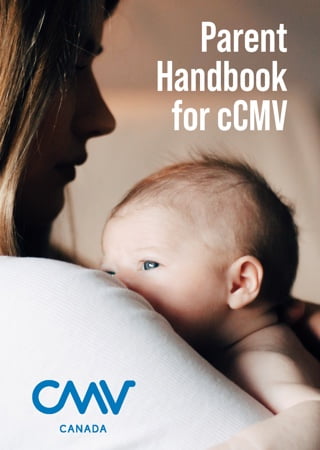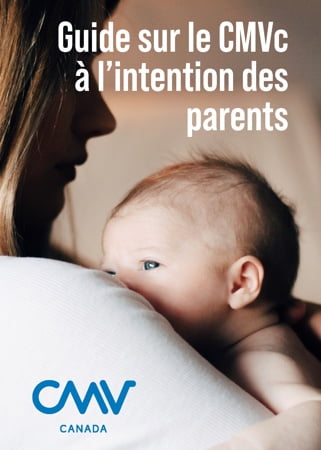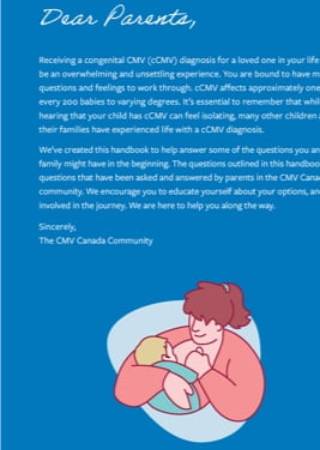Resources
THE CAREGIVER
HANDBOOK
We’ve put together this handbook to offer answers to some of the questions you and your family might have right from the start.



Canadian newborns infected during pregnancy.
cases of cCMV result in lifelong disability.
women living with a child infected with CMV will develop the infection.
Remember to use soap and water for about 15 to 20 seconds, especially after spending time with young children or handling items like diapers, drool, or other bodily fluids. This practice is particularly important when little ones are attending childcare.
Instead of giving a kiss on the lips, opt for a kiss on the forehead instead. This is particularly important if you’re expecting.
When you’re disposing of diapers, tissues, or other items that might have bodily fluids, make sure not to touch your face until you’ve had a good handwashing session.
Avoid sharing glassware and kitchen utensils to prevent the spread of CMV. Keep things tidy by regularly cleaning toys and countertops. It’s a good practice to also regularly clean surfaces that come in contact with children’s urine or saliva.
The majority of babies with congenital CMV appear healthy when they’re born. However, babies with congenital CMV who exhibit illness at birth typically display noticeable signs and symptoms, including:
Premature birth
Low birth weight
Yellow skin and eyes
(jaundice)
Enlarged and poorly
functioning liver
Purple skin
splotches, or a rash,
or both
Abnormally small
head (microcephaly)
Enlarged spleen
Pneumonia
Seizures
We’ve put together this handbook to offer answers to some of the questions you and your family might have right from the start.















Universal newborn screening for congenital Cytomegalovirus (cCMV) isn’t consistently applied in all Canadian provinces. While a few provinces have initiated pilot programs or are now screening all newborns at birth, it hasn’t been uniformly adopted.
Because policies can evolve, we advise verifying the current status of universal newborn screening for cCMV in Canada by reaching out to your local provincial health authorities. Stay informed for the latest updates.
Currently, there isn’t an available vaccine for CMV. However, the pharmaceutical industry has shown promising advancements in this area.
Exciting developments are happening in the field of clinical research. Phase 3 CMV vaccine trials are actively seeking participants at five Canadian locations: Toronto, Burlington, Quebec City, Montreal, and Mirabel.
To gather more information about these trials, please contact Centricity Research. You can reach them by email at join@centricityresearch.com, by phone at 1-833-323-JOIN, or visit their website at https://lmcmanna.com.
For comprehensive insight into mRNA vaccines and Moderna’s vaccine development, explore https://cmvictory.com/.
Babies impacted by cCMV may experience a wide spectrum of lifelong effects. Remarkably, the majority of babies born with cCMV (about 4 out of 5) will progress without any issues, developing just like any other child.
However, for some infants, lasting effects can range from hearing loss to cerebral palsy. Untreated hearing loss could potentially worsen over time, underscoring the importance of consistent audiological examinations for your child’s developmental journey.
Navigating the unfamiliar can be challenging. It’s reassuring to keep things in perspective – take gradual steps and focus on managing what you can, especially when it feels like everything else is beyond control.
While a few symptomatic babies can receive an in-utero diagnosis, most do not. Symptoms can vary greatly, and oftentimes they might not manifest at all. In certain instances, symptoms are subtle and can be easily overlooked. Astonishingly, around 80% of symptomatic babies remain undiagnosed.
The awareness of cCMV is surprisingly limited within the broader population. In fact, a staggering 91% of mothers have not even heard of the virus. CMV Canada is actively collaborating with the medical community to increase awareness among healthcare providers and the public at large.
Treatment for newborns with cCMV is initiated upon the detection of signs and symptoms. The specific approach hinges on the nature and severity of these indicators.
Among the most prevalent treatments is the use of antiviral medications, which effectively inhibit the virus’s replication. Ongoing research delves into the development of novel medications and vaccines aimed at treating and preventing CMV.
If your newborn’s test results indicate CMV, it’s important to engage in a conversation with your healthcare provider regarding the suitability of antiviral medications.
Antiviral treatment is typically safe, effective, and well-tolerated. The most notable concern is the potential decrease in the baby’s white blood cell count, which might render them more susceptible to bacterial infections. Regular blood tests are essential to maintain a healthy range. Importantly, no instances of infertility or cancer have been attributed to this treatment.
Tips for Administering Medication as a Parent:
Don’t forget to review Canadian regulations for travelling with medication.
Your contribution fuels progress in congenital CMV research, support, and advocacy. Join hands with us to amplify the impact of our initiatives and create a stronger, healthier future for every family affected by congenital CMV.